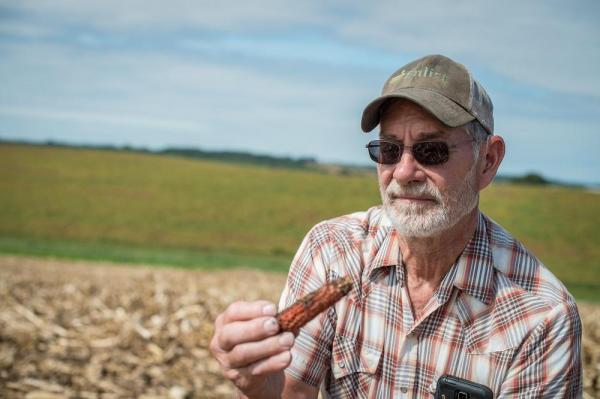
EVANSVILLE, Ind., June 20 (UPI) — Decades after fertilizer runoff from Midwest corn fields created a massive dead zone in the Gulf of Mexico, corn growing states are slowly changing their farming practices to address the problem.
But scientists say it will take many more decades before their efforts have an effect.
“We just haven’t done enough yet,” said Jim Gulliford, a regional administrator with the Environmental Protection Agency. “The task is very large, and it’s going to take years.”
Scientists have known about the Gulf’s dead zone since the 1980s. It’s an area where there is not enough oxygen in the water for fish to survive.
The zone is caused predominantly by nitrate fertilizers that run off Midwestern agricultural fields and travel down the Mississippi River into the Gulf. Once there, the fertilizers stimulate intense algae growth. The abnormally thick algae sucks the oxygen from the water, choking out other marine life.
In 2017, the zone spanned nearly 9,000 square miles, an area about the size of New Jersey.
Besides the profound environmental impact, the phenomenon is devastating Gulf Coast fishermen.
“It’s bad,” said Philip Dyson, a commercial shrimp fisherman based in Louisiana. He spoke in early June from the deck of his boat where he and his wife were working. “It’s getting hard to earn a living. This is all I’ve done all my life, since I was 17 years old. But there are times I don’t know how we’re going to keep doing it.”
There’s nothing Dyson or his fellow fishermen can do. The only way to reverse the dead zone is to stop the flow of nitrate fertilizers into the Gulf. Their fates are in the hands of Midwestern farmers.
The good news for Dyson is corn growers are trying to address the problem.
Stopping soil erosion
Nearly 1,000 miles north, in Jasper County, Iowa, Roger Zylstra, a second-generation farmer, is one of the first in his area to experiment with strategies to stop soil eroding from his fields.
Zylstra’s family has always been conservation-minded, he said. He hopes his actions will have a positive impact on the Gulf. But he is more concerned with the impact nitrate runoff has closer to home. In Midwestern states, like Iowa, nitrates from corn operations infiltrate local watersheds and pollute drinking water.
“I have a responsibility of being a good neighbor and taking care of our land and our water,” Zylstra said.
Corn needs large amounts of nitrate fertilizer to grow, Zylstra said. He can’t stop fertilizing his fields. But he has tried several techniques to limit the runoff.
The most promising, he said, is the use of “cover crops.”
Science backs this up. Most fertilizer runoff occurs during the fall, after the corn is harvested, and spring, before it is planted. During these periods the fields are bare, and rain washes away large quantities of the heavily fertilized soil, said Craig Cox, a biologist with the Environmental Working Group, a nonprofit organization dedicated to research and education.
Cover crops stop this by securing the soil.
This benefits farmers, Cox said. Keeping nitrates and other nutrients on the fields through the winter means there is more available for the next year’s crop. Over time, the more nutrient-rich soil creates larger yields.
“It works,” Cox said. “It takes a few years for it to work, before farmers really start to see the best results. But it does work.”
Zylstra has noticed a difference. He began planting cover crops on parts of his land five years ago. Already, his fields require less fertilizer and are more productive, he said.
“We are convinced it increases the productivity of the soil,” Zylstra said.
Zylstra, who is a director on the Iowa Corn Promotion Board, now encourages other farmers to plant cover crops.
Early results positive
Likewise, Iowa’s government has committed millions of dollars since 2013 to helping farmers reduce agricultural runoff. On June 1, the EPA gave the Iowa Department of Agriculture $1 million for the same purpose.
State officials are quick to point out that their efforts are starting to pay off — there are a few small watersheds across the state where nitrogen levels are dropping.
“You can see it happening much more quickly in smaller watersheds,” said Adam Schneiders, the water quality research coordinator at Iowa’s Department of Natural Resources.
As more farmers commit to reducing runoff, the state should see more widespread results, Schneiders said.
Other Midwestern states have also begun committing resources to reduce nitrate runoff. But the process is slow. Between 2015 and 2016, less than 3 percent of Iowa’s corn fields were planted with cover crops, according to a survey conducted by the EWG. The same was true in Illinois. Indiana did a little better, with about 7 percent of fields covered.
“The problem is these measures are all voluntary,” said Kimberly Van Meter, a researcher at the University of Waterloo’s Ecohydrology Research Group. “We tell farmers about them, but they’re all voluntary.”
That’s bad news for the Gulf, Van Meter said. Even if Midwestern states eliminated 100 percent of their nitrogen runoff this year, it would still take 30 to 50 years for the Gulf of Mexico to recover. There are “legacy nutrients” stored in soil and groundwater from decades of corn farming in the Midwest that will continue washing into the Gulf for years after real-time fertilizer runoff stops, said Van Meter, who recently authored a study on the issue.
Midwestern states have no time to lose. They need aggressive and targeted efforts to eliminate fertilizer runoff, Van Meter said. At this rate, it will take many decades to reverse the impact on the Gulf of Mexico — if not lifetimes.
In the meantime, Gulf Coast fishermen, like Dyson, are left to wait and hope that when they head out onto the Gulf tomorrow there will be fish there to catch.




